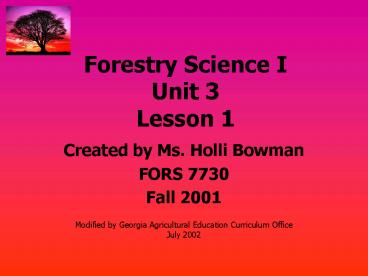Forestry Science I Unit 3 Lesson 1 - PowerPoint PPT Presentation
1 / 10
Title:
Forestry Science I Unit 3 Lesson 1
Description:
Phloem -- located outside the cambium layer. ... Cork cambium -- the thin layer of cells between the phloem and the bark itself ... – PowerPoint PPT presentation
Number of Views:27
Avg rating:3.0/5.0
Title: Forestry Science I Unit 3 Lesson 1
1
Forestry Science IUnit 3Lesson 1
- Created by Ms. Holli Bowman
- FORS 7730
- Fall 2001
Modified by Georgia Agricultural Education
Curriculum Office July 2002
2
Introduction
- Trees rank only second to grass in their
distribution on the earth. - Forest land owners need to be familiar with the
trees on their land.
3
What is a tree?
- A tree is a woody plant having one well-defined
stem and a formed crown and usually attaining a
height of at least 8 feet. - It has three main parts roots, stem and crown.
4
Functions of the roots
- Serve to anchor the tree against wind and other
forces of nature - Rootlets are smaller roots that come from the
largest roots - Root hairs are fine, hair-like roots which
extract nutrients and water from the soil that
are necessary for the trees growth
5
Functions of the stem
- Also known as the trunk
- Transports food, water and minerals up and down
the plant - Produces the bulk of the useful wood in a tree
6
Functions of the stem
- Heartwood -- the darker-colored wood of the
center portion of large trees. This wood is
dead. This core serves only to give the tree
strength and keep it upright. - Xylem -- located outside the heartwood, this is a
lighter-colored wood also know as sapwood. It is
the living portion of the tree. It is the means
by which raw nutrients and water are carried from
the roots to the crown as well as a storage area
of food synthesized in the leaves.
7
Functions of the stem
- Cambium -- located outside the sapwood and inside
the bark. This layer of active cells is
responsible for the growth of the tree and
forming a new annual ring each year. - Phloem -- located outside the cambium layer.
This layer of living cells is also called the
inner bark. It carries food made in the leaves
down to the branches, trunk and roots. It is
protected by the dead, non-functioning outer
bark. - Cork cambium -- the thin layer of cells between
the phloem and the bark itself which forms the
outer bark.
8
Functions of the crown
- Serves as the manufacturing plant of the tree
by making food for the rest of the tree - Is composed of branches, twigs and leaves
- Part of the tree where photosynthesis occurs
9
Functions of the crown
- Leaves -- part of the tree which contains green
chloroplasts - Photosynthesis -- process in which leaves turn
sunlight, carbon dioxide and water into
carbohydrates (starches and sugars). Oxygen is a
by-product of photosynthesis. - Transpiration -- process by which water brought
to the crown of the tree moves as water vapor
into the atmosphere.
10
Functions of the crown
- Stomata -- pores of the leaves through which
transpiration occurs. - Respiration -- process in which a tree consumes
oxygen and some food to obtain energy for growth
and other biological processes. The tree gives
off carbon dioxide and water as end products.































